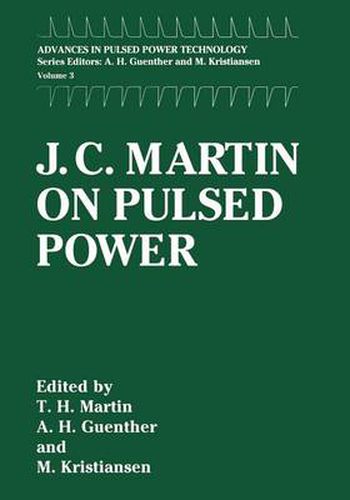Readings Newsletter
Become a Readings Member to make your shopping experience even easier.
Sign in or sign up for free!
You’re not far away from qualifying for FREE standard shipping within Australia
You’ve qualified for FREE standard shipping within Australia
The cart is loading…






This title is printed to order. This book may have been self-published. If so, we cannot guarantee the quality of the content. In the main most books will have gone through the editing process however some may not. We therefore suggest that you be aware of this before ordering this book. If in doubt check either the author or publisher’s details as we are unable to accept any returns unless they are faulty. Please contact us if you have any questions.
As indicated in the Foreword to this series on Advances in Pulsed Power Technologies, the pioneering roots of modern pulsed power as related by J.C. Charlie Martin and his co-workers of the Atomic Weapons Research Establishment, Aldermaston, Reading UK is an important if not essential record of the experiential history of the major developer of pulsed power advances during the post-World War II period. It finds great utility as an instructive accounting of the trials, tribulations and, finally, an almost chronological walk through their thoughts as they diligently and happily travel the yellow brick road to success. It is recounted in the inimitable style of Charlie Martin as only he can relate, with some insightful perspectives by Mike Good man, a constant companion, and collaborator who shares his unique view of Charlie and the Aldermaston Group. This collection of selected articles is unique, for in large part, the documentation of their struggle and final triumph have not been formerly published in any archival manner. One reason, we suspect, was the defense-related application and significance of their work, compounded by the constant need for progress which did not allow for the time consuming preparation of formal submission to the literature. This also explains the urgent and sometimes terse manner of their writings. Yet the material remains remarkably current because we are dealing, in large measure, with pulsed systems less sensitive to those factors involved in slower pulsed scenarios.
$9.00 standard shipping within Australia
FREE standard shipping within Australia for orders over $100.00
Express & International shipping calculated at checkout
This title is printed to order. This book may have been self-published. If so, we cannot guarantee the quality of the content. In the main most books will have gone through the editing process however some may not. We therefore suggest that you be aware of this before ordering this book. If in doubt check either the author or publisher’s details as we are unable to accept any returns unless they are faulty. Please contact us if you have any questions.
As indicated in the Foreword to this series on Advances in Pulsed Power Technologies, the pioneering roots of modern pulsed power as related by J.C. Charlie Martin and his co-workers of the Atomic Weapons Research Establishment, Aldermaston, Reading UK is an important if not essential record of the experiential history of the major developer of pulsed power advances during the post-World War II period. It finds great utility as an instructive accounting of the trials, tribulations and, finally, an almost chronological walk through their thoughts as they diligently and happily travel the yellow brick road to success. It is recounted in the inimitable style of Charlie Martin as only he can relate, with some insightful perspectives by Mike Good man, a constant companion, and collaborator who shares his unique view of Charlie and the Aldermaston Group. This collection of selected articles is unique, for in large part, the documentation of their struggle and final triumph have not been formerly published in any archival manner. One reason, we suspect, was the defense-related application and significance of their work, compounded by the constant need for progress which did not allow for the time consuming preparation of formal submission to the literature. This also explains the urgent and sometimes terse manner of their writings. Yet the material remains remarkably current because we are dealing, in large measure, with pulsed systems less sensitive to those factors involved in slower pulsed scenarios.